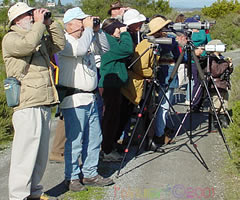
Ways to Improve Your Birding Skills
Before going on a field trip, make a list of the birds you are likely to see and check them out in your field guide. Take the list with you and compare that list with the birds that you actually do see. You’ll find that your birding skills will improve.
When out in the field, don’t fumble with your field guide, but watch a bird as long as you can, making notes on its appearance and behavior. What is it doing? What size is it? What shape is it? What color? What are its prominent marks? Does it have wing bars, an eye line, a long tail? Resist the temptation to check the field guide when you can be observing the bird. The bird will eventually fly away, but the bird’s picture will remain in the book.
Want to buy binoculars? Wondering where to start? If you buy an inexpensive pair of binoculars rather than the pricey pair you thought you liked, you might be sorry later on. If you buy those big heavy binoculars, you might find them agonizing with all that weight hanging around your neck causing you misery on every birding trip. Suggestion: Before investing, try to gather all the information you can, especially from your birding friends. What brand and power do they have? What do they like or dislike about them? Is the cost reasonable? Where do you go to buy them? Would you buy the same pair again?

Dress for success. Bright clothing worn when out birding can frighten away the birds. Especially avoid bright white clothing as white is a color that indicates danger to wildlife. Think of a deer lifting it’s white tail when alarmed. Many of today’s fabrics are made with artificial brighteners that are attractive to humans, but can startle or scare away the very birds we are trying to watch. Even some of our dull-colored clothing has been “brightened.” Out in the field, it is better to wear old clothes that have been washed many times. Besides, they are a lot more comfortable.
Ever wonder why field guides are organized the way they are? Why water birds come first? It is not an arbitrary decision. The answer is taxonomy. Most field guides use the same sequence that is used by scientists, which reflects what scientists think is the evolutionary relationship between birds. This is a simplified answer. However, be wary of field guides that choose a different system of organizing the birds such as by color, size or habitat. Stick to the scientists’ system. It will prove easier to use in the long run.
Are you a “spisher”? Spishing is a sound made by hissing through closed teeth to attract birds in the bush. When on a field trip, ask your leader and your fellow birders how they feel about spishing. If they find it annoying, don’t spish. If they’re pro-spishers, then spish away. But don’t overdo it! One spisher at a time is enough.